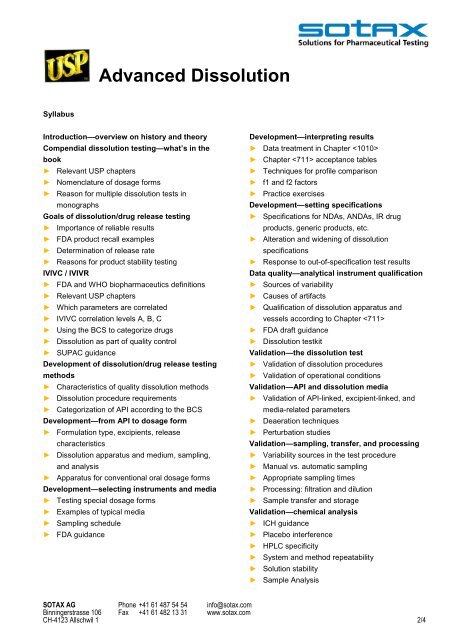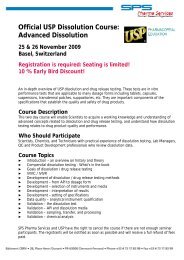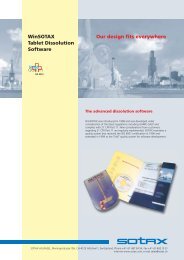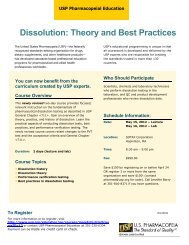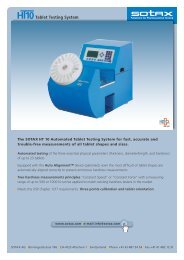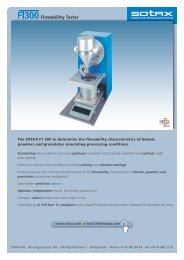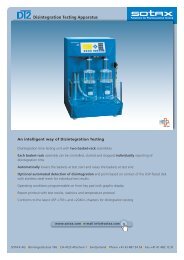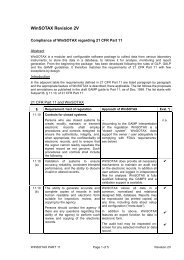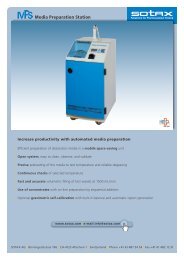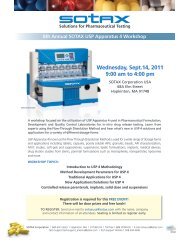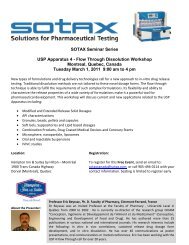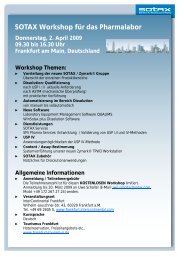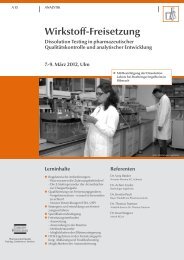Official USP Course - Sotax
Official USP Course - Sotax
Official USP Course - Sotax
Create successful ePaper yourself
Turn your PDF publications into a flip-book with our unique Google optimized e-Paper software.
Syllabus<br />
Advanced Dissolution<br />
Introduction—overview on history and theory<br />
Compendial dissolution testing—what’s in the<br />
book<br />
► Relevant <strong>USP</strong> chapters<br />
► Nomenclature of dosage forms<br />
► Reason for multiple dissolution tests in<br />
monographs<br />
Goals of dissolution/drug release testing<br />
► Importance of reliable results<br />
► FDA product recall examples<br />
► Determination of release rate<br />
► Reasons for product stability testing<br />
IVIVC / IVIVR<br />
► FDA and WHO biopharmaceutics definitions<br />
► Relevant <strong>USP</strong> chapters<br />
► Which parameters are correlated<br />
► IVIVC correlation levels A, B, C<br />
► Using the BCS to categorize drugs<br />
► Dissolution as part of quality control<br />
► SUPAC guidance<br />
Development of dissolution/drug release testing<br />
methods<br />
► Characteristics of quality dissolution methods<br />
► Dissolution procedure requirements<br />
► Categorization of API according to the BCS<br />
Development—from API to dosage form<br />
► Formulation type, excipients, release<br />
characteristics<br />
► Dissolution apparatus and medium, sampling,<br />
and analysis<br />
► Apparatus for conventional oral dosage forms<br />
Development—selecting instruments and media<br />
► Testing special dosage forms<br />
► Examples of typical media<br />
► Sampling schedule<br />
► FDA guidance<br />
Development—interpreting results<br />
► Data treatment in Chapter <br />
► Chapter acceptance tables<br />
► Techniques for profile comparison<br />
► f1 and f2 factors<br />
► Practice exercises<br />
Development—setting specifications<br />
► Specifications for NDAs, ANDAs, IR drug<br />
products, generic products, etc.<br />
► Alteration and widening of dissolution<br />
specifications<br />
► Response to out-of-specification test results<br />
Data quality—analytical instrument qualification<br />
► Sources of variability<br />
► Causes of artifacts<br />
► Qualification of dissolution apparatus and<br />
vessels according to Chapter <br />
► FDA draft guidance<br />
► Dissolution testkit<br />
Validation—the dissolution test<br />
► Validation of dissolution procedures<br />
► Validation of operational conditions<br />
Validation—API and dissolution media<br />
► Validation of API-linked, excipient-linked, and<br />
media-related parameters<br />
► Deaeration techniques<br />
► Perturbation studies<br />
Validation—sampling, transfer, and processing<br />
► Variability sources in the test procedure<br />
► Manual vs. automatic sampling<br />
► Appropriate sampling times<br />
► Processing: filtration and dilution<br />
► Sample transfer and storage<br />
Validation—chemical analysis<br />
► ICH guidance<br />
► Placebo interference<br />
► HPLC specificity<br />
► System and method repeatability<br />
► Solution stability<br />
► Sample Analysis<br />
SOTAX AG Phone +41 61 487 54 54 info@sotax.com<br />
Binningerstrasse 106 Fax +41 61 482 13 31 www.sotax.com<br />
CH-4123 Allschwil 1 2/4


